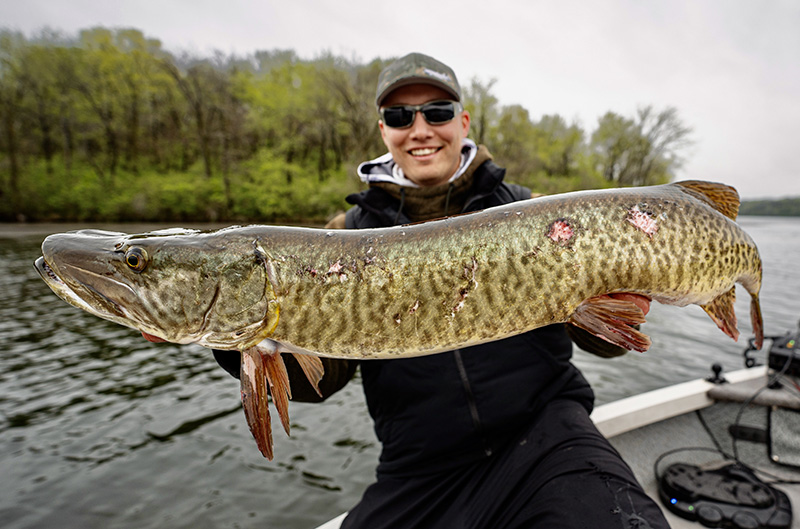How to Target Iowa Muskie

How to Target Iowa Muskie
Early summer is a fantastic time to learn how to target Iowa muskie in the southern part of the Midwest muskie range. Depending on where you are, places throughout the Midwest have a yearlong season for these fish. Unlike the upper parts of the Midwest and muskie range that usually have a season which revolves around the spawn. Just make sure to check your local regulations before heading out to hunt these elusive fish. Before you head out, make sure to have the proper release tools for these fish. For your safety and that of the muskie. That includes, but isn’t limited to, a large net, long and short pair of pliers, jaw spreaders, and hook cutters.
Favorite Bait
With prep taken care of, there are three main types of baits I lean on and how I target Iowa Muskie. The Baits include horizontal baits, pull pause baits, and rubber baits. In the spring, muskies tend to favor smaller presentations over the bigger ones. Not that you won’t be able to catch fish on bigger baits, but over the years I have had the most luck on baits in the 6-8” range for springtime and early summer fishing. This is part of the reason muskie fisherman become frustrated at this time of year. While bass and walleye fisherman seemingly catch more muskies than the muskie fisherman. When it comes to muskies it’s important to remember nothing is ever set in stone. With these fish and the number one rule of muskie fishing is that the muskies make the rules.
Regardless of how successful muskie have been at spawning in a given lake or body of water, they will always go through the motions. This spawning cycle will bring the fish shallow and, depending on weather, water, and forage. This puts these fish in very accessible locations for a few weeks. From these shallow locations, fish will eventually funnel out into deeper water to recover from the spawn. This “funneling” process allows anglers a unique opportunity to target these fish. Where they are more vulnerable to angling due to a combination of factors. Those factors include a calorie deficit from the spawn, warming water beginning to ramp up their metabolism, and the vulnerability of prey species coming into spawn after the muskies have gone through their spawning process.
Horizontal Presentations
The horizontal presentations is one way how I target Iowa muskie, I will lean on in the spring vary from lake to lake depending on the type of cover and forage, and the general depth of the fish at the time. For these presentations I tend to focus on three lures mainly. Small spinnerbaits are great and will work their way efficiently through thick cover, such as weeds or trees. I really like smaller bucktails to trigger reaction strikes from active fish. These are usually size #8 (or smaller) and I use both single- and double-bladed models. Bucktails are a great way to judge the activity level of the fish on a given day on the water. If they are chasing down and eating bucktails, it’s going be a fun day of fishing! Lastly, and probably the most underrated horizontal bait in my opinion, is the swimbait. These are great options to give muskies a different look and trick finicky fish into biting. Finding 8” swimbaits are invaluable and I lean on heavily throughout the season. In the spring the way I think of a swimbait is like a subtle bucktail, and generally these are something I would utilize in tough conditions such as high skies and high pressure.
Pull Pause Baits
For pull pause baits there are three main types that I lean on this time of year: dive and rise style lures, glide baits, and twitch/crank baits. These baits are most effective when you cater the presentation to the water and depth that you are fishing. I really like to try and give my baits as much hang time and neutral buoyancy in the water as possible this time of year. I want those fish to get a good look at the bait without having to worry about the fish seeing me as the water in my area is generally clearest in the spring
Twitch/Crank style lures are fantastic as well for this time of year. My favorite for early summer is the 6” or 9” crank. I usually will crank them to depth one third of the cast then twitch back one third of the cast and then crank them into the figure eight to end the cast. Just like with any fish, making contact with cover will only up your odds of success.
Rubber Baits
Last and likely my favorite lure for all times of the year throughout the musky range would be rubber. One of the reasons I like rubber lures so much for musky fishing is because, in my opinion, there are few lures that trigger muskies to strike like a rubber lure ripped in front of their face. It’s also impossible for two people to work rubber lures the exact same way. Which makes presentation vary just enough to trigger more strikes. My favorite way to trigger strikes with these lures all times of the year, is allowing the bait to contact cover and then ripping the bait free. Usually, these bites are triggered by ripping the bait free of weeds, but I have had bites happen after making contact with timber as well. Sharp pops of the rod give these baits a lot of action in the water and despite looking a little strange out of the water they have a ton of life and action in it.
Early summer is one of my favorite times to target muskies in my home state of Iowa. They can be an incredibly challenging fish to pursue. With vast amounts of time invested punctuated with brief moments of sheer chaos and terror. If you are lucky enough to catch one of these apex predators. Please exercise the utmost care so another angler can experience the thrill of that same fish. Remember muskies make the rules, good luck in your pursuit, and tight lines.
By: Matt Eyman-Vavroch
June 2025


